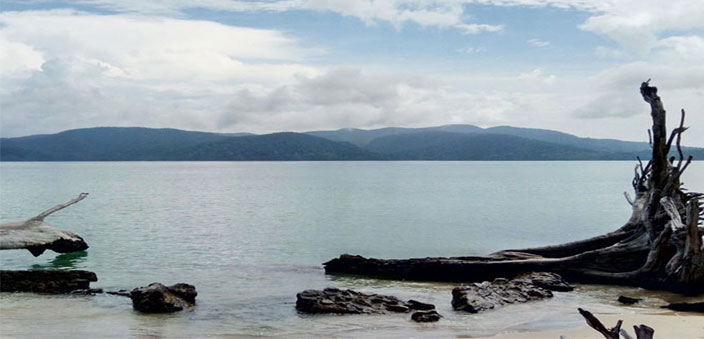Text and Photos: Ishma Raina
India is globally known for its cultural, ethnic and geographic diversity – a tag that it holds with great pride. Amidst these immense roars of thriving cultural heterogeneities, stand quietly the island clusters of the Andaman and Nicobar, overlooked not just in our geography lessons, but also in our awareness and travels. The Andaman islands are still addressed as ‘Kaalapani’ by many – which portrays best the limelight that surrounds both its history, as well as geography. It has, however, become highly essential to learn, and more important, unlearn certain notions and ideas that we may otherwise hold of these islands – it is important to reconstruct the identity of Andamans, and look at them from a completely different light in order to know India better. When mainland India holds such diversity that can be tirelessly explored, why should one take the effort to go to these islands so far away from the shore? Or to put it more simply – why Andamans? The answer lies in one simple statement – the Andamans are a timeless paradise of solitude.
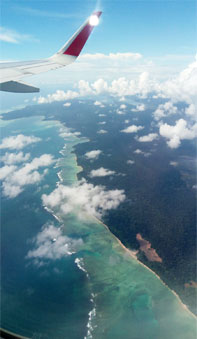
So near, yet a world away
The closest mainland ports (both air and sea) from Port Blair are Chennai, Vishakhapatnam and Kolkata, and the entire journey by flight seems like one through a seamless canvas – the colours of the sky and the waters of the Bay of Bengal merging into a horizon-less azure. With a terraced topography, Port Blair has the capability to out-do any other city of the country when it comes to town planning and a smoothly running state machinery. The maintenance of the city is top notch, which not only reflects the efficiency of the government machinery, but also highlights the disciplined way of life that the people of Port Blair live. The beauty of Port Blair is in the fact that it chooses to live without the intervention of various multinational joints, yet lacks no amenities; there may be no KFC (Kentucky Fried Chicken), but there sure will be an AFC (Andaman Fried Chicken). The city is adorned with well laid out roads, and a beautifully constructed pathway by the sea, that could very well be the Marine Drive of Andamans! Port Blair also has a great sanitation and hygiene system, and can do well as the brand ambassador for the government’s Swachh Bharat Mission.
One of the most important features of Port Blair is that despite being like any other small town, the demography of the place is highly cosmopolitan. The native tribes mostly inhabit the remote interiors of the forests in the Andamans, and there are strict rules regarding interaction with these communities, prohibited in most areas. While the majority people in Port Blair are Tamilians and Bengalis from mainland India, one can find people from every corner of the country, most visible in the Aberdeen Bazaar, the central market of the city that was constructed by the British during the colonial rule; here, a Kashmiri handicrafts shop co-exists with a Kanjeevaram sari shop; momo-s and butter chicken are sold in joints right next to each other.

The Cellular Jail and its place in history
A few kilometres from the clock tower of the Aberdeen Bazaar is a steep road that does the work of a time machine – the hullabaloo of the city market is replaced with a stoic silence – a silence which leads to the place that the Andamans are most infamous for – the Cellular Jail. The outer facade of the prison complex looks like the entry to a grand fort, eclipsing brilliantly the horrific history that was written beyond the walls of that gate. The first look at the prison complex is breathtaking – not in a romanticised way, but just because of the majesty of the complex. The Cellular Jail is an architectural marvel, a radial prison complex brilliantly laid out in seven spokes, with the outer end of each spoke walled, and all of the inner ends merging at one common watchtower, where a guard would always be on duty. This watchtower also has a large bell that was kept in order to raise an alarm. Presently, only three out of seven spokes stand in good condition. Another major characteristic of these spokes is that no two spokes have prisons facing each other – cells of one spoke face the blank rear walls of the cells in another spoke. This in itself is a sadistic sight, and as visitors, we cannot even bring themselves to fathom the level of isolation the prisoners of the jail were subjected to.
Restoration and renovation techniques used in the preservation of the Cellular Jail also play a major role in the overall impact that the first appearance of the jail has on the visitors. While the entire prison complex is spick and span; the gardens are well laid out and the hedges trimmed, the main spokes of the prison have been left in the same state as they were during the colonial role. One loses track of time right at the first look of the building – it is mighty, scary, and one is overwhelmed and stirred to the core at first glance itself. Needless to say, the idea of not painting the walls of the spokes and leaving them in its original state is a bold symbolic gesture. The ageing, moss covered prisons, weathered over years and years of heat, wind and rain seem to tell the story of ‘Kaalapani’ way better than anything else can.
The prison complex was fully built within the span of a decade, from 1896 to 1906, and the prisoners deported to Andaman were put to use for carrying out the construction. The Cellular Jail maintains an exhibition site that depicts the draconian torture methods used by the British to torment the prisoners, the inhuman and inhospitable conditions that they were made to work and live in. The prison complex also houses administrative offices as well as the gallows where many of the inmates were executed. The Light and Sound show at the Cellular Jail narrates the heart wrenching series of events, with a peepal tree of the complex personified to be the narrator of the show. This peepal tree was planted during the construction years of the jail, and was uprooted during a massive storm. The tree was then replanted – it miraculously survived and still stands tall.
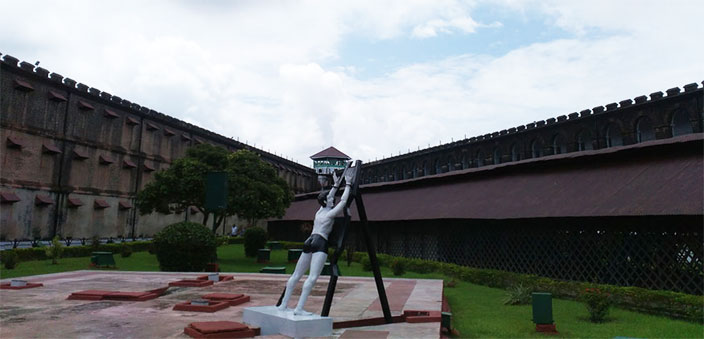
The prisons are open for visits as well, the most famous one being that of Vinayak Damodar Savarkar/Veer Savarkar. The dimension of each cell is about 15 feet in length and 9 feet in width, with only one small ventilator on one wall; this makes one wonder how the inmates managed to live their lives in such isolation. The central watchtower has the names and tenure of all the inmates of the Cellular Jail, engraved upon it. From the top of the jail are visible the islands of Ross and North Bay, which are famous for two very different reasons. Both these islands are closest to Port Blair, and smaller ships are used to ferry people to and fro between these islands. Port Blair has a top notch water sports complex where all the ships dock.
Hopping the islands
Ross Island is one of the 572 islands of the Andaman and Nicobar, and is probably one of the least known sites of the colonial history of India. Situated three km to the east of Port Blair, Ross Island served as the administrative headquarters of the British from 1856 to 1941. A massive earthquake led to the destruction of the infrastructure at the Ross Island, the remnants of which still exist, however, in extremely dilapidated conditions. Currently under the Indian Navy, Ross Island is now uninhabited. It is an area of one sq.km, and holds the ruins of what was a thriving, flourishing settlement not very long ago. It becomes really easy to paint a picture of Ross Island in all its glory as one walks by the remains of the bazaar, bakery, secretariat, club, tennis court, swimming pool and church among other buildings of the settlement. Most buildings of the Ross Island are not only in ruins, but are also slowly being taken over by thick foliage. Inspite of having faced the wrath of many a calamity, it seems like Ross Island wishes to fight not only time, but also ‘tide’, and quite literally, so that it can live to tell its tale. Archaic architecture being consumed by old trees is not a sight that one gets to see every day; thereby making Ross Island a compulsory place to visit when planning a trip to Andaman (and otherwise too). One may even find a deer or two strolling through the bazaar of Ross Island (who do not entertain pictures and selfies, by the way!).
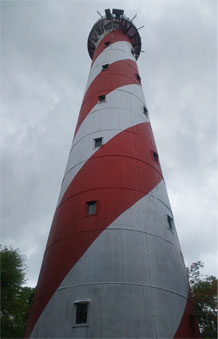
Ross Island is also special because it contains within itself a historical timeline of almost two centuries. After the earthquake of 1941, most British abandoned the island. But shortly after, Ross Island came under the control of the Japanese troops in 1942, who remained there till 1945 (until Japan’s surrender in the Second World War.) The Japanese too, left their mark on the island in the form of bunkers to safeguard the island.
The third vertex in the island triangle of Port Blair and Ross Island is the North Bay Island – which has the third largest coral reef in Asia, thereby making it a hot favourite for adventure junkies. The North Bay Island is easily spotted even from a distance, mainly because of the north point lighthouse, which stands at the highest point of elevation of the island. A portrait of the North Bay Island is featured at the back of twenty rupee notes, which is also how most tourist guides introduce the North Bay Island to the visitors. Situated at a distance of eight km from Port Blair, only a certain part of the island is open for exploratory purposes. While many people go in for snorkelling, scuba diving and sea walking, one can also just sit by corals on the shore, explore the small market on the island, or walk up to the North Point Lighthouse, which is about 72 m above sea level, and is regulated and maintained by the Ministry of Ports and Shipping. With a simple entry ticket, all of ten rupees, and a little bit of effort of climbing up eight floors, one can access the top floor of the lighthouse. The view from the top of the lighthouse is very liberating. As one overlooks the islands and the vast expanse of the waters of the Bay of Bengal merging with the sky, many boundaries are transcended, and barriers broken. It feels like one has managed to embrace the infinite.
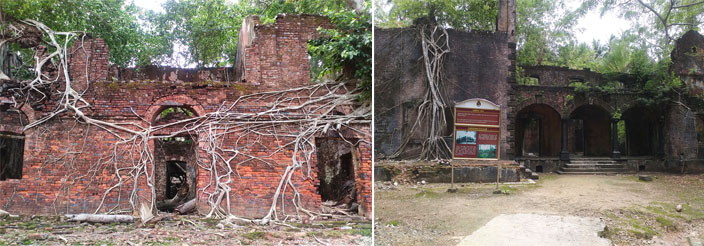
The furthest southern tip of South Andaman Island is at a distance of roughly 25 km from Port Blair, and can be accessed by road. Chidiya Tapu, also known as the “Bird Island” and “Sunset Point”, is considered to be one of the best places to see the sunset at Port Blair. The drive of about an hour takes you through most interiors of Port Blair and the countryside, and you can also stop over to grab a cup of tea from the local stalls by the sea. The beach is rather small, bordered by sea walls and mangrove trees, and is right adjacent to a biological park that houses forty six varieties of birds, white spotted deer, reptiles like crocodiles and monitor lizards, and the endemic Andaman monkey. Chidiya Tapu is the perfect spot for those who seek proximity to nature during their vacations or explorations – calm, tranquil and serene, just the right kind of view that is needed to unwind. On the shore, all one can hear is the crashing of waves, and the sounds of the birds from among the surrounding forests. For those who are mostly used to the blaring sounds of horns and loudspeakers in their everyday lives, the reduction in decibel is surely a welcome change!
Hopping to 41 km northeast of Port Blair is the island which is most famously known to be the site of the best beach in Asia – the Radhanagar Beach. Named after Sir Henry Havelock, a British General who served in India, Havelock Island is one of the few places where the Andaman and Nicobar administration has authorised for the development of tourism. Habitation on the island gained ground especially after the 1971 Indo-Pak war, when the then Prime Minister of India, Indira Gandhi realised the proximity of Havelock to Bangladesh, thereby granting them permission to migrate to the island – which is reflected in the current demography of the island. In a population of approximately 15,000, most of the people are Bengali settlers. The islands can be reached by government ferries as well as private cruises, and take a minimum of two hours of travel time.
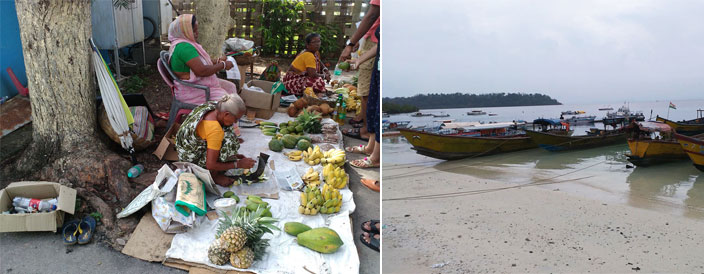
Havelock has an interesting mix and match of huts with thatched roofs standing right next to a resort and a kathi roll joint. Havelock has its share of tourists from abroad as well, and many of them have also chosen to stay back! There is one market in the island, where most of the groceries and fisheries are brought, bought and sold. The quality of amenities however, is not as fine as it is in Port Blair, and people have to often to rush to Port Blair for something as simple as getting automobiles repaired or serviced. Havelock is most famous for its sublime beaches, Elephant Beach, Laxmanpur Beach, with the Radhanagar Beach being the most famous one, especially because of its white sand and a canopy of the surrounding rain -fed forests. The beaches at Havelock are perfect places to lounge on a hammock with a book in hand. The local cuisine and sea food adds to the holiday vibe in the best way possible.
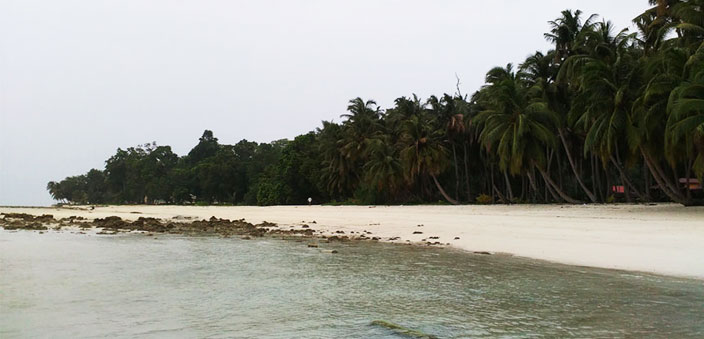
There are other islands of the Andaman archipelago like Long Island, Viper Island, and Neil Island, which can be visited to further know the Andamans better. A running theme with all the beaches of the Andaman islands is that most beaches do not have markets right at the shore – they’re a little before the beach begins; and this has helped in maintaining the cleanliness on the beaches. The waters at the shore are so clear that one can choose the stones or corals that they want to stand on, or can see the vivid changes in the colour of the sea water at regular distances. While most administrations across the country struggle to keep the coastlines and beaches clean, the administration of Andaman has done a commendable job of maintaining the beaches.
Many believe that the geographic detachment of the Andaman and Nicobar Islands is its biggest undoing. At a time when advertisement is the only way to attain promotion, the Andaman and Nicobar Islands are still waiting to be found and explored by the people of its own country. Like most states have their tourism advertisements, it will be great if the department of tourism thinks of the beauteous archipelago waiting to be acknowledged for what it has to offer. Another effort can be made by improving the amount of information available in the academic syllabi on the Andaman and Nicobar Islands, and not just make it synonymous to the land of infamous history and a fatal tsunami. Everyone has a different idea of a heaven, and for those who seek, you might even find your heaven in this small group of islands that breathes life into you every second of your time there.

